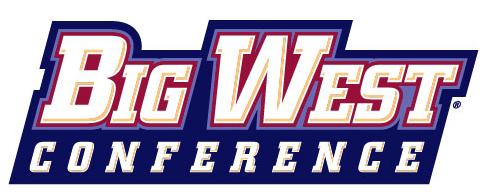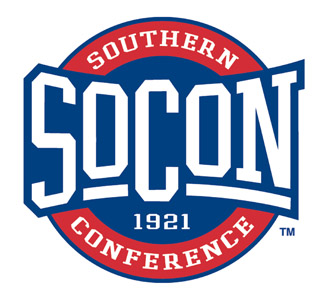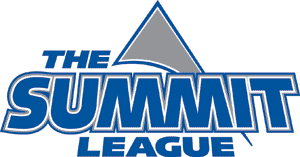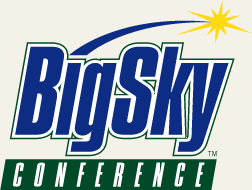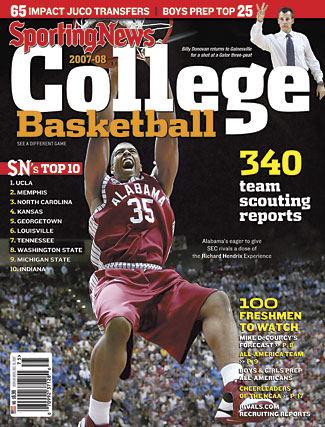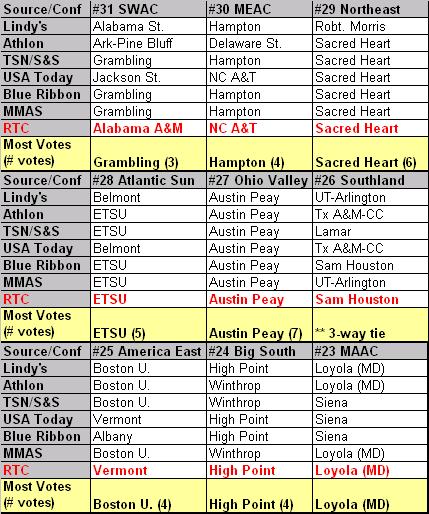Conference Primers: #15 – MAC
Posted by rtmsf on November 6th, 2007
Predicted Order of Finish:
East
- Kent St. (22-6) (13-3)
- Miami (OH) (16-10) (11-5)
- Akron (17-12) (9-7)
- Ohio (12-15) (7-9)
- Bowling Green (12-16) (6-10)
- Buffalo (7-19) (4-12)
West
- Western Michigan (19-11) (11-5)
- Central Michigan (16-11) (10-6)
- Toledo (14-14) (9-7)
- Eastern Michigan (14-13) (8-8)
- Northern Illinois (9-19) (5-11)
- Ball St. (6-22) (3-13)
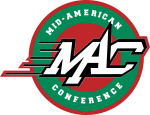
WYN2K. We went back and forth on where to rank the MAC because conveniently pigeonholing this league into low- or mid-major status is very difficult to do. Historically, the league hasn’t been more than a one-bid league (since 1985 the MAC has received two NCAA bids only five times), but it has consistently done well with the teams that it puts into March Madness, ranking among the top five conferences in terms of exceeding its expected number of NCAA wins (aka overachieving). Using historical measures of success by seed, the MAC (as an average #12.0 seed) should have won only 12.04 NCAA Tournament games over the last 23 years – instead it has won fifteen. So given this dichotomy in its character, we started looking at recent history to gain a deeper understanding of where the MAC should fall on the ladder. We’re probably going to upset the MAC folks out there, but ultimately we were swayed by the fact that the league has been a one-bid league with no first round wins (losing by an average of 8.8 pts) over the last four seasons (despite having a winning record of 192-186 against OOC opponents the last three years). That was enough to convince us to keep the MAC (for now) at the top of the low majors. But it was a very close call.
Predicted Champion. Kent St. (#12 seed NCAA). The Golden Flashes are our choice to win the MAC this year (again, shamelessly unoriginal). But what’s not to like with this team? They return all five starters from a team that went 12-4 in conference last year, and a program under the tutelage of Jim Christian who has never had an under-20 win season at the school (KSU has had nine straight 20 win seasons). No one player stands out offensively on this defensive-minded club (#22 nationally in defensive efficiency last year), but 6’7 forward Haminn Quaintance is the man shoring up the team D from the inside (#15 in stl% and #33 in blk% nationally). Kent St. has a difficult, but not insane (see: Miami (OH) for that), nonconference schedule, featuring games against mid-majors Xavier, St. Louis and George Mason at home, while going to Chapel Hill in early January to play UNC.
Others Considered. We like Western Michigan to win the West Division, but that doesn’t necessarily mean we think they’re the second-best team in the conference. Like Kent St., the Broncos also return all five starters, but the 2007 version of WMU simply (16-16) wasn’t as good as Kent St. (21-11). Their ultimate destiny may depend on the offseason development of the most excellently-named guard David Kool, last year’s MAC FrOY, a player who seems to do a little bit of everything. Last year’s miraculous champion Miami (OH) was also considered simply because they have Charlie Coles still at the helm and you know you’re going to get a hardnosed defensive team (#28 nationally in eFG% defense; MU didn’t allow a single opponent to score 70 pts last seaon) that tests itself with an extremely tough nonconference schedule every year – this year’s includes five NCAA teams, one NIT team + Cincinnati on the road. Akron getting left out of both the NCAA and the NIT last year despite 26 wins has to still sting coach Keith Dambrot. But if he’s to become vindicated with a MAC championship this year, he’ll have to do so without conference POY (and former Lebron HS teammates) Romeo Travis and team leader PG Dru Joyce. Can the Zips find point guard play to support another run? They do return five of the top 500 most efficient offensive players in the country (contributing to a #12 raw offensive efficiency), so there is a fair chance of another great season. Another team that is probably still a year away from competing for the MAC title but is worth watching is Central Michigan. CMU went from 4-24 in 2006 to 13-18 in 2007, and the pieces are beginning to align for former UCLA assistant coach and current head man Ernie Ziegler. He returns four starters including Giordan Watson, the leading returning scorer (18.8 ppg) in the MAC this season. Last year’s league regular season champ, Toledo, lost its top three scorers and is expected to drop off somewhat despite returning the league’s DPOY Kashif Payne.
Games to Watch. The MAC has a fair number of televised games this year, so you can actually watch some of these, as opposed to watching for them. Keep in mind the unbalanced sixteen-game schedule.
- Kent St. @ Miami (OH) (01.17.08) & Miami (OH) @ Kent St. (03.04.08)
- Western Michigan @ Kent St. (01.27.08)
- Miami (OH) @ Akron (01.05.08) & Akron @ Miami (OH) (02.19.08)
- Central Michigan @ Western Michigan (01.22.08) ESPNU & Western Michigan @ Central Michigan (03.04.08)
- ESPNU Bracketbusters (02.23.08)
- MAC Championship Game (03.15.08) ESPN2
RPI Booster Games. Like the Big West, the MAC doesn’t play a lot of BCS teams, largely because they want home-and-homes and the higher profile schools aren’t willing to risk a loss when they get a Southland or Sun Belt team to take the one-game lump payment along with their whipping. Last year the league was 4-25 (.138) against BCS teams, and there are 21 such games on the schedule this year (along with quite a few mid-major games). Oh, and who does Ohio U. know at ESPN – they’re scheduled to be on the family of networks at least nine times this year!
- New Mexico St. @ Ohio (11.09.07) ESPN FC
- Western Michigan @ Oregon (11.10.07) ESPN FC
- Vanderbilt @ Toledo (11.13.07)
- Davidson @ Western Michigan (11.21.07)
- Central Michigan @ Minnesota (11.24.07) ESPN 360
- Eastern Michigan @ Notre Dame (12.01.07)
- Miami (OH) @ Louisville (12.01.07) ESPN FC
- Ohio @ Kansas (12.15.07) ESPN2
- Western Michigan @ S. Illinois (12.18.07)
- Kent St. @ UNC (01.02.08) ESPN
Odds of Multiple NCAA Bids. There’s always a reasonable shot for the MAC to get multiple bids, but we wouldn’t call those odds good this year. Looking at what happened to Akron last year suggests that the only team that would have a shot at an at-large would be Miami (OH) if they had a great record and lost in the conference tournament.
Neat-o Stat. There are three new and somewhat accomplished coaches coming into the MAC this season – Ricardo Patton (Northern Illinois), formerly of Colorado where he took the Buffs to 2 NCAAs and 4 NITs in eleven seasons; Louis Orr (Bowling Green), formerly of Seton Hall where he took the Pirates to 2 NCAAs and 1 NIT in five seasons; and Billy Taylor (Ball St.), formerly of Lehigh who is taking over from the troubled tenure of Ronny Thompson there.
64/65-Team Era. As we alluded to above, the MAC can make a reasonable case for inclusion into the mid-major category (we define a mid-major conference as one that consistently competes for and receives at-large NCAA bids, minus the BCS conferences). Despite overachieving when MAC teams make the NCAA Tourney with four teams making the Sweet 16 or better (Kent St. in 2002), it still only has had five years of multiple bids (two each time – 1985, 1986, 1995, 1998, 1999) in this era. And as you can see, none have occurred during the 2000s. For now, let’s enjoy the ending of last year’s MAC Championship game. Bedlam.
Final Thought. The conference is very balanced, as five different programs have tasted the NCAA over the last five years, and only twice has a school had the good fortune to go B2B in winning the conference crown (Ball St. – 1989 & 1990; Kent St. – 2001 & 2002). So it should be no surprise if someone besides Miami (OH) steps up and takes the title this year. Befitting a conference that has quality depth, we see no fewer than six teams that could make a legitimate run at the conference championship, and a couple more who could easily act the role of spoilers. As always, the MAC plays quality basketball and is worth catching when you get a chance.





























